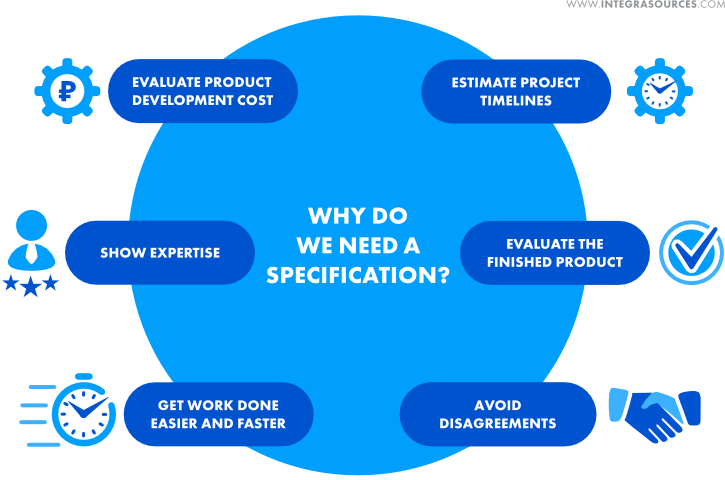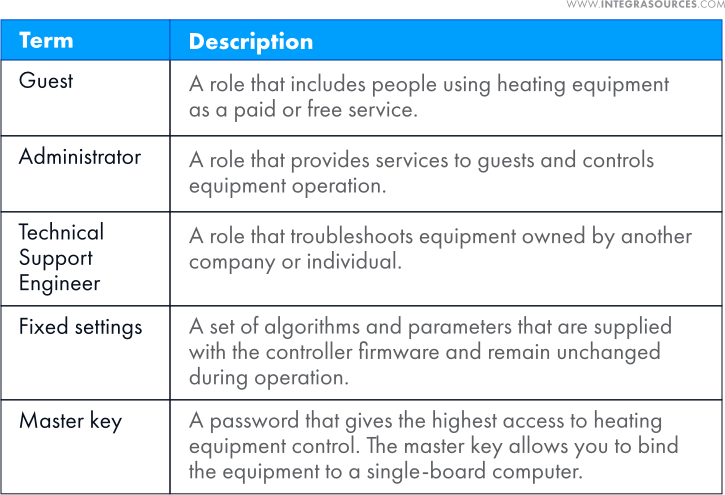Project Development Specification: How To Write the Right One
Every successful technology product started as a mere idea. Most of the time, these brilliant ideas come from individuals with no background in software or hardware development.
It’s fantastic when passionate individuals with innovative thoughts and visions aim to enhance their businesses. After all, they know their needs better than anyone else. However, the key lies in having technical experts who can truly grasp these ideas and transform them into functional devices or programs.
A project development specification plays a critical role in bringing ideas to life effectively. Why is it essential to draft specifications? Who should prepare them, and how should they be written? Is it possible to proceed without a requirements document? How can one avoid overpaying for creating such a document? You’ll find all the answers in this article.
Let’s dive deeper into the world of technical specifications and uncover the secrets behind successful product development.
Why Do We Need a Specification?

A project development specification for hardware and software serves as a document outlining the requirements for an IT product, including its purpose, functions, behavior, components, technologies, development tools, and processes.
Such a document acts as a roadmap for both the business and technical teams involved in creating an IT solution.
A well-prepared project development specification is equally valuable for both the client and the developer. As a collaborative effort by specialists from different fields, the specification serves as a reference for the client and contractor throughout the entire development lifecycle and beyond.
- For clients, a project development specification enables them to obtain initial cost estimates for product development. The cost of complex devices and high-performance applications can be challenging to estimate offhand. Many factors, such as labor, components, logistics, certifications, and more, must be considered. A well-crafted document allows both the contractor and the client to visualize and evaluate the entire development process and its stages, giving the client an idea of the preliminary cost of each stage. More precise data is outlined in a project estimate.
- A specification outlines an approximate timeline for the project. Both the client and the outsourcing company will avoid disputes if every stage of the project is clearly marked in the document from the start. While hardware and software development timelines can shift due to unforeseen circumstances, some delays—such as waiting for components or shipping times—can be anticipated during the specification drafting phase.
- With a well-written specification, the client will find it easier to evaluate the final solution—whether it’s an electronic device, application, firmware, or hardware-software system—by comparing it with the description provided in the document. Hence, the specification should be prepared thoughtfully and comprehensively.
- A well-prepared project development specification speaks volumes about the competence and experience of the specialists who drafted it. The developers' meticulous approach to preparing the project, along with the clear and thorough information provided in the specification, demonstrates the company’s level of service.
- Joint work can be disrupted or paused due to external factors like financial constraints, geopolitical issues, partner disagreements, or major logistical challenges. With a well-crafted project development specification, it becomes simpler for the client to resume collaboration with the outsourcing company or to find a new partner.
- The requirements document details the product itself, its purpose and functionality, as well as the development stages, electronic components, and software tools to be utilized. Thus, both the client and the developer gain a comprehensive understanding of the future IT solution, serving as protection against disagreements, misunderstandings, and unplanned changes in the product concept.
When developers rely on a requirements specification, their work becomes easier and faster, eliminating the need to coordinate every step with the client.
Can We Do It Without a Spec?
Writing a project development specification isn’t straightforward. It requires time, expertise, and, inevitably, money. Consequently, some clients might opt to save time and money by preparing in-house specifications or skipping the requirements document altogether.
Is it possible to proceed without a technical specification? Can a client simply explain their product idea verbally, show a sample, or request something similar to a template?
Even a relatively small project necessitates a requirements document—a paper that records all the product, component, and workflow requirements. While this document may not strictly follow the classical definition of a project development specification, it is indispensable.
When reaching out to a custom software and hardware development company, the client can provide a document detailing their ideas, wishes, and vision for the product in any form.
The client’s expertise in design and programming is advantageous, but the key is to communicate their product wishes as clearly as possible.
Based on this explanation, the development company will create a full-fledged, high-quality requirements specification that serves as a guideline for subsequent development.
How to Write a Spec
A technical specification includes subject data and detailed descriptions of the development process. The more complex the task, the more specialists will be involved in drafting the requirements specification, resulting in a more extensive finished document.
Who Writes a Requirement Document?

One cannot rely solely on templates or tips found online to create a good specification.
Requirement documents for hardware and software development are crafted by specialists who understand the intricacies of the process: work stages, timelines, necessary components and technologies, and the final product characteristics. Project managers, developers, and testers contribute their data to form an overall project picture.
You can assign the creation of project development specifications to in-house specialists who know precisely what product you need and can detail the desired functions and characteristics of the device or program in the document.
However, this often leads to redundant work, wasting time and money.
A requirements document prepared by an outsourcing company takes into account all the client's wishes and the contractor's capabilities (expertise in specific components and languages, development experience, etc.).
All points in the technical specification must be agreed upon by the customer and the developer to ensure the client receives a product that meets all requirements.
What Should Be Included in a Project Development Specification?
Requirement documents are tailored to specific projects and, generally, are unique. Nonetheless, some points appear in one form or another in all technical specifications for software, hardware, and embedded systems development.
Terms, Abbreviations, and Definitions
At the beginning of the document, the terms used in the text are defined. These can include IT concepts (element names, development environments, programming languages, and technical definitions), as well as words and designations from the field for which the IT solution is intended.
The more carefully the list of professional terms is thought out, the better the contractor and the customer will understand each other.

Product Summary
This section describes the purpose of the IT solution, the reasons for its creation, and the target audience.
Businesses often seek to develop an IT product to expand their client base, enhance the company's reputation, boost labor productivity, reduce manual tasks, and so on.
This paragraph also includes information about the project's objectives: it could involve developing a complete solution, contributing to a specific stage (for instance, working on software for an existing hardware platform), or enhancing an existing product.
Objectives must be specific and clear to ensure the final product meets the requirements and proves beneficial to the customer.
Project Requirements
The project requirements form the core of the specification and its most detailed and essential part.
Typically, this section contains the following subsections:
General Requirements outline the phases of the development process.
Here is an example of general requirements for developing a hardware and software system for equipment control:
Project Stages:
- Develop a controller to manage client devices.
The controller must be installed on each device.
- Create a device control panel using a Linux-based single-board computer.
- Develop an application for remote control.
- Integrate the control panel and controller into a single system.
- Test the system.
- Subsequent system improvements and modifications
Functional Requirements refer to the IT solution's functions and behavior.
Example:
- The system should send notifications about equipment failures.
- The system must control the sensors.
- The system must transmit data over a radio channel.
- The system must have an alarm.
- The system must manage all the device functions.
Non-Functional Requirements define performance, scalability, maintainability, product security, and other criteria.
Requirements for the Development Process can be presented in several paragraphs and describe work stages, components, and software tools to be used.
For example, in a project development specification for a software and hardware complex, you might need a paragraph detailing the requirements for the device, communication protocols (MQTT, TCP, etc.), and a user application for managing the device.
The statement of Organization and Quality of Work determines how everything related to the project will be arranged: communication between the customer and the contractor, the main points regarding the quality of the system, device, or software product (continuous operation time, system behavior in emergencies, and so forth).
Security Issues may contain requirements for code protection, access control, access rights, etc.
In addition to the main points, the specification contains blocks that are unique to each project, such as roles for access control, interface requirements, and requirements for the device size and appearance.
What Is a Good Project Development Specification?
What should a high-quality specification for hardware and software development look like? How long should it be—one page or fifty? Should it use formal language or technical jargon? Do you need images or not?
First, the project development specification should be written in clear and simple language, as it will be studied not only by technical specialists but also by sales managers and the client's team. Of course, technical terms are unavoidable, but they shouldn’t overwhelm the text.
Schematics, drawings, and tables are not mandatory but highly recommended. Visual elements convey information more comprehensibly to many people.
The size of the specification depends on the project’s scale and complexity. The larger the project, the more preparatory documents are needed. A requirements specification for a battery management system, a project spanning several years, cannot be confined to a single page.
However, it’s crucial to strike a balance between conciseness, clarity, and informativeness even when writing technical specifications for large-scale projects.
What happens if you neglect proper preparation and study of the specification? At best, it will require additional time. At worst, it can lead to disagreements between parties and result in a product that doesn’t meet the client’s expectations.
We’ve encountered such situations. Our client had an idea for a device, but some of its functions couldn’t be implemented simultaneously. In the specification document, we described the only viable solution, but unfortunately, the client overlooked it. Suffice it to say, the outcome disappointed him.
To prevent such outcomes, the client should dedicate time to studying the specification: discussing details and delving into the finished document.
It’s better to entrust the preparation of technical specifications to professionals—the same team that will handle the IT solution creation. Whether or not you have a clear understanding of the development process, you can simply bring them your idea.
A competent outsourcing team specializing in custom electronics design and software development can draft a high-quality specification, discuss all the details with the client, consider all wishes, and select the most suitable component base and software tools.
A good specification will save time, money, and stress for both the client and the developer.
Common Mistakes in Specifications
It’s vital to avoid common mistakes when drafting a requirements document. Let’s examine some pitfalls closely.
No Glossary
What it was: The virtual assistant provides voice interaction, MX Player, Spotify, TuneIn, Audible, Pandora, Hungama, and Ganna playback, and information about EPL, MLB, NBA, NHL, etc.
What it should be: The virtual assistant provides voice interaction, music playback (MX Player, Spotify, TuneIn, Audible, Pandora, Hungama, and Ganna), and information about sports events (EPL, MLB, NBA, NHL, etc.).
Music services: MX Player, Spotify, TuneIn, Audible, Pandora, Hungama, Ganna.
Abbreviations of sports organizations:
EPL: English Premier League
MLB: Major League Baseball
NBA: National Basketball Association
NHL: National Hockey League
Unclear Wording
What it was: Since its introduction in 1983, MIDI has developed into a mature standard with a wide range of products and applications. It is a standard that specifies both the hardware connection needed to share the data physically as well as the data protocol for exchanging musical control information.
What it should be: The MIDI (Musical Instrument Digital Interface) format allows you to standardize musical equipment from different manufacturers.
The protocol provides digital data transfer between devices, music playback, and control of auxiliary equipment (pyrotechnics, lighting, etc.).
Too Detailed Description
What it was: The GS Format is a set of guidelines created by Roland to standardize the performance of sound-generating equipment. It supports all features listed in the General MIDI System. Additionally, the highly compatible GS Format gives a greater variety of sounds, allows for sound editing, and specifies numerous specifics for a wide range of supplementary features, such as chorus and reverberation effects.Â
The GS Format was created with the future in mind, making it simple to add additional sounds and support new hardware features as they become available. It may be retrofitted to work with the General MIDI System. As a result, Roland's GS Format can faithfully play back GM Scores just as well as GS Music Data (music data written using the GS Format).
What it should be: The GS format is Roland's extension to the General MIDI standard to unify audio equipment characteristics. It supports all the features listed in the General MIDI System, supplementing the standard with new instruments, effects, and functions.
Mixing Functional and Non-Functional Requirements
What it was: The system must maintain the water temperature in the heating tank at no higher than 50°C.
What it should be: Functional requirements: the system must maintain a user-defined water temperature.
Non-functional requirements: the water temperature in the heating equipment must not exceed 50°C.
Conclusion
The development of an IT solution—an electronic device, application, embedded software, or IoT system—is preceded by the creation of a project requirements specification. Depending on the project’s scale and complexity, a specification can be a brief document or an extensive, detailed one.
A specification provides insight into the product’s purpose and functions, the requirements for its development, the work stages, and the acceptance procedure for the completed solution.
The requirements document is the result of teamwork among the project manager, developers, testers, and, of course, the customer.
As writing technical specifications is a complex process, it demands deep knowledge and expertise in software and hardware development. Those preparing specifications should be able to navigate the electronic components market, assess logistics routes, and present information effectively.
The best choice would be to entrust the preparation of the requirements specification to an outsourcing development company. The team will consider its expertise and all the client’s wishes. In this case, product development will progress faster and more smoothly.
You can reach out to Integra Sources with your idea, and we will help you create a unique application, electronic device, or software and hardware system of any complexity. We will prepare a concise and understandable requirements specification, which will serve as the foundation for further collaboration.
high speed mixing granulator,wet material rotary granulator,screw extrude granulator
Jiang Yin Jun Lang Machinery Co.,Ltd , https://www.fluidbeddry.com
